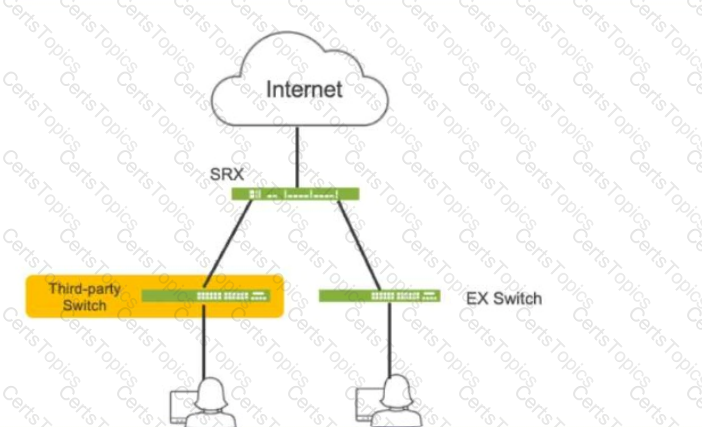Understanding the Scenario:
Objective: Deploy IPsec VPNs connecting multiple enterprise sites using OSPF for dynamic routing.
Challenge: Some sites use third-party devices not running Junos OS.
Considerations:
Compatibility between Juniper and third-party devices.
Support for dynamic routing protocols (OSPF) over IPsec VPNs.
Handling overlapping IP address spaces.
Option Analysis:
Option A: OSPF over IPsec can be used for intersite dynamic routing.
Explanation:
OSPF Characteristics:
IPsec Limitations:
Standard IPsec tunnel mode does not support multicast traffic natively.
Multicast traffic cannot traverse IPsec tunnels unless encapsulated.
Juniper Solution:
Juniper devices can use routed VPNs (route-based VPNs) with st0 interfaces, allowing OSPF over IPsec.
However, this requires support from both ends of the VPN tunnel.
Third-Party Devices:
Conclusion:
[Reference:, "OSPF can be run over IPsec VPNs using route-based VPNs, but interoperability with third-party devices must be verified.", Source: Juniper TechLibrary - OSPF over IPsec VPNs, , Option B: Sites with overlapping address spaces can be supported., Explanation:, Overlapping IP Address Spaces:, Occurs when different sites use the same IP subnets., Can cause routing ambiguities and conflicts., Solution:, NAT over VPN:, Use Network Address Translation (NAT) to translate overlapping IP addresses to unique addresses., Juniper devices support NAT over IPsec VPNs., Third-Party Device Considerations:, Need to ensure third-party devices support NAT over IPsec., Many enterprise-grade devices provide this functionality., Conclusion:, Option B is true; overlapping address spaces can be supported using NAT., Reference:, "When sites have overlapping IP addresses, NAT can be used over IPsec VPNs to resolve address conflicts.", Source: Juniper TechLibrary - NAT with IPsec VPNs, , Option C: OSPF over GRE over IPsec is required to enable intersite dynamic routing., Explanation:, GRE Tunnels:, Generic Routing Encapsulation (GRE) can encapsulate multicast and broadcast traffic., Allows OSPF packets to be transmitted over IPsec VPNs., IPsec Encryption:, GRE tunnels can be encrypted using IPsec for secure communication., Interoperability:, GRE over IPsec is a common method to support OSPF between devices from different vendors., Third-party devices are more likely to support GRE over IPsec than OSPF over IPsec directly., Conclusion:, Option C is true; using OSPF over GRE over IPsec is required in this scenario., Reference:, "To run OSPF between devices that do not support multicast over IPsec, GRE tunnels can be used over IPsec VPNs.", Source: Juniper TechLibrary - Configuring GRE over IPsec, , Option D: Sites with overlapping address spaces cannot be supported., Explanation:, Contradicts Option B., As established, overlapping address spaces can be supported using NAT over IPsec VPNs., Conclusion:, Option D is false., , Conclusion:, Correct Answers: B and C, Option B: Overlapping address spaces can be supported using NAT over IPsec VPNs., Option C: OSPF over GRE over IPsec is required to enable intersite dynamic routing, especially when third-party devices are involved., , Additional Detailed Explanation:, Why OSPF over IPsec May Not Be Feasible (Option A):, Multicast Traffic:, OSPF relies on multicast for neighbor discovery and updates., IPsec in tunnel mode does not natively support multicast traffic., Third-Party Devices:, May not support proprietary extensions or configurations required to run OSPF directly over IPsec., Workaround:, Encapsulate OSPF multicast packets within GRE tunnels, which can carry multicast traffic over unicast IPsec tunnels., Why OSPF over GRE over IPsec Is Necessary (Option C):, GRE Tunnels:, Encapsulate multicast/broadcast traffic into unicast packets., Allow routing protocols like OSPF to function over IPsec VPNs., Compatibility:, GRE is a widely supported protocol across different vendors., Facilitates interoperability between Juniper and third-party devices., Supporting Overlapping Address Spaces (Option B):, NAT over IPsec:, Translates private IP addresses to unique addresses across the VPN., Prevents routing conflicts and allows communication between sites with overlapping subnets., Considerations:, Requires proper configuration on both ends of the VPN tunnel., Third-party devices must support NAT over IPsec., References to Juniper Security Concepts:, Route-Based VPNs:, "Route-based VPNs use virtual tunnel interfaces (st0) and support dynamic routing protocols over IPsec.", Source: Juniper TechLibrary - Route-Based VPNs, GRE over IPsec:, "GRE over IPsec allows the transmission of multicast and non-IP protocols over IPsec tunnels.", Source: Juniper TechLibrary - GRE over IPsec Overview, NAT with IPsec VPNs:, "NAT can be applied to IPsec VPN traffic to resolve overlapping address issues and facilitate communication between sites.", Source: Juniper TechLibrary - NAT with IPsec, Final Notes:, Interoperability:, When working with third-party devices, always verify compatibility for protocols and features., Best Practices:, Use GRE over IPsec for dynamic routing protocols requiring multicast support across IPsec VPNs., Implement NAT over VPN when dealing with overlapping address spaces., , , ]

